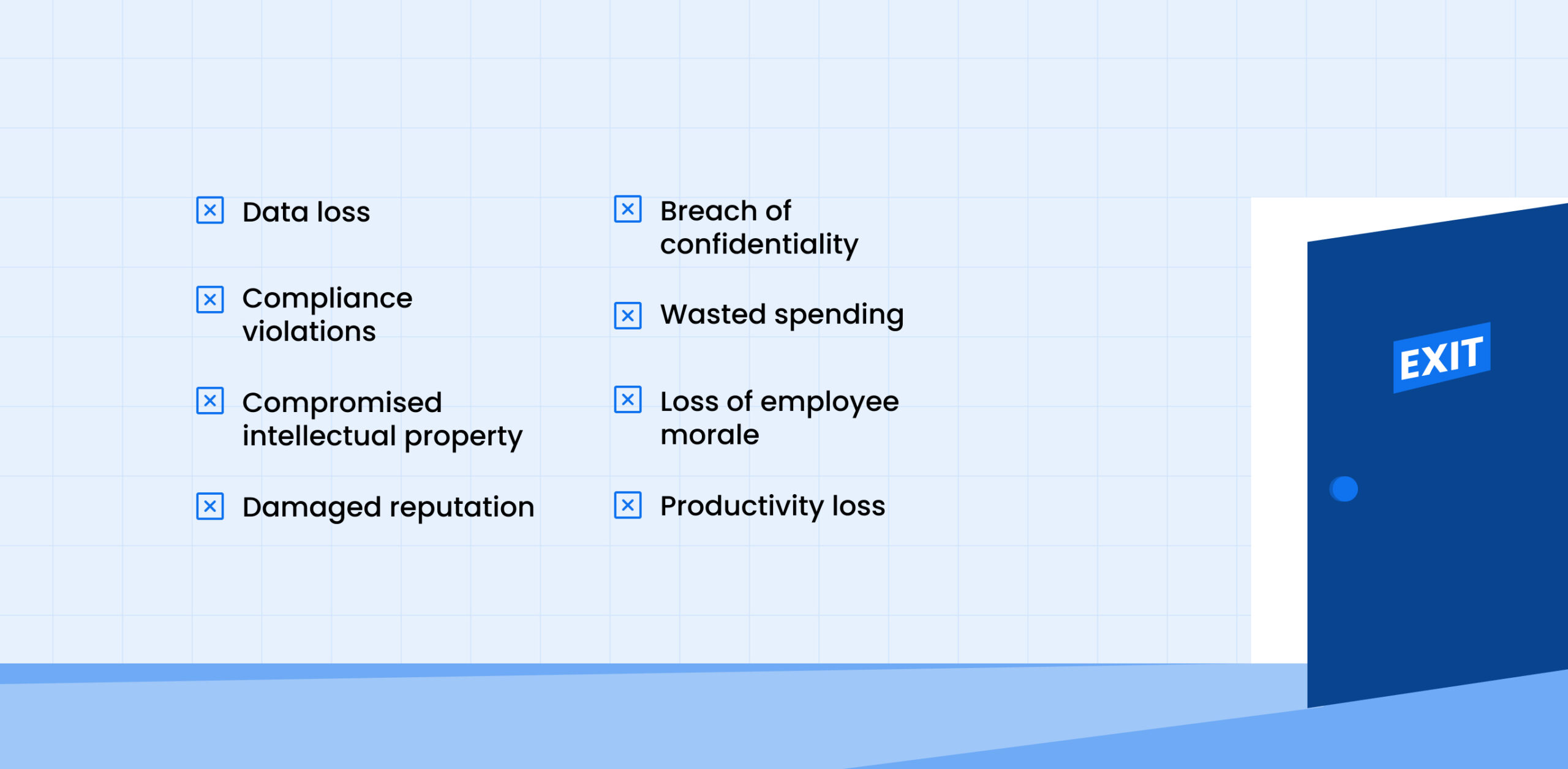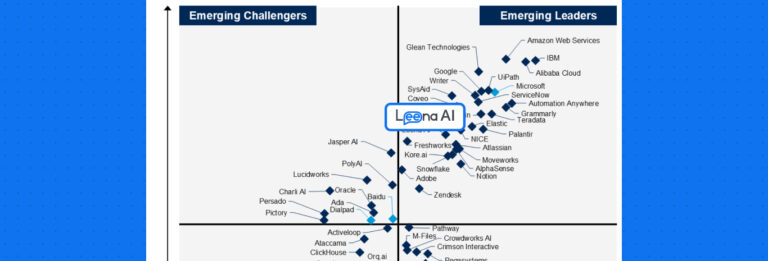Employee onboarding and offboarding are two opposite spectrums of an employee’s journey. But many companies consider the offboarding investment as a waste of resources.
While they devote much effort to onboarding, offboarding often gets much less focus. But how you part ways with an employee is just as critical to establishing a positive employer brand. According to reports, only 29% of companies offer a formal and seamless offboarding process.
We have previously discussed the monumental impact offboarding has on business growth. But what exactly happens when you do an improper employee offboarding?
Read this blog to explore the impact of a poor offboarding process and how it can be detrimental to your company’s success.
Status quo: Most companies struggle with offboarding
Parting with an employee on a pleasant note is crucial to maintaining a successful company. Despite that, improper employee offboarding is quite common among companies.
According to reports by TechRepublic, 48% of businesses know that their former employees still have access to internal corporate systems. 20% have also experienced data breaches because of a former employee. Further, a survey found that 86% of respondents believe remote work has changed the security landscape significantly.
About 50% of IT experts have stated that an ex-employee account remains active for more than a day after they leave. 30% said it takes about a week to deactivate a former employee’s account after their departure, while the remaining 20% said it takes them over a month.
The statistics show that these organizations are open to severe risks of data breaches and compliance violations. Not revoking access as soon as an employee exit allows the former employee to make changes to shared resources, share company data with others, or sell confidential information to your competitors.
Risks of improper employee offboarding and how to address them

Inappropriate employee offboarding keeps you from mitigating the substantial risks of letting an employee go. Here are some you should be careful about:
Data loss
The primary risk of poor employee offboarding is the threat of losing critical data. Employee attrition is not always a mutual decision. It can sour the relationship between an employee and an employer.
Improper employee offboarding can be detrimental to company data security. Without effective processes, an ex-employee may still have access to confidential data.
If the attrition is not mutual, an employee may hold a grudge against the company and use the data for malicious intent. Damage to the data can also happen unintentionally if an ex-employee still has access.
Whatever the reason, any unauthorized external use of company data can compromise an organization’s growth and success. It is crucial to have streamlined offboarding processes. It would help you revoke access to files, devices, and critical accounts. It will prevent the departing employee from misusing any important data contained there.
It is common for companies to use common passwords for shared work accounts. In some companies, the staff shares passwords through word of mouth, while others use password-managing tools. To prevent them from accessing those accounts in the future, ask your IT department to change the passwords as soon as the offboarding formalities finish.
Compliance violations
The risk of damaged or lost data can land you in several compliance violations. Poor employee offboarding can result in the loss of sensitive information. It can lead to HIPAA compliance violations.
If any ex-employee damages or leaks sensitive information, HHS can start an investigation. They could destroy or even leak this information. That, in turn, can lead to losing exorbitant money for non-compliance.
Fines for HIPAA can cost as much as $1.5 million for a compliance violation and can cause jail time for certain circumstances relating to malicious intent.
Avoiding this requires revoking departing employees’ access to applications and services. Your offboarding process should also include preventing file sharing with other email addresses.
Ask your IT department to revoke the ex-employee’s access to all internal applications. Make it a point to double-check which applications may retain authentication even after you change the passwords.
Compromised intellectual property
Non-physical assets are an essential part of the business. The patents, inventions, designs, and product names companies create to give them an edge against competitors. It also helps establish credibility in the market. Protecting your intellectual property empowers you to take advantage of your innovations and creativity.
However, there can be possibilities where a departing employee can use this data against you. Poor onboarding heightens the chance of an ex-employee intending to steal your intellectual property.
The non-streamlined process can also result in losing confidential data—an ex-employee can sell the compromised information to your competitors. Any leak of documents, client contacts, and other paperwork can heavily harm your business.
The best way to prevent this issue is by taking a strict privilege approach. Each employee in the company should have access to only the necessary information to do their jobs and nothing more. It makes offboarding easier to manage when an employee leaves.
You can enable role-based access and set up user guidelines for providing access to employees, managers, and clients. Organizations should take active measures to improve digital security while offboarding a worker. You can also consider saving data in a secure and secret location.
Make it a point to restrict email forwarding once an employee leaves. An ex-employee simply forwarding personal notes from your internal system can cause a data breach, even if unintentional.
As soon as an employee formally leaves their job, ask IT to collect or delete all company-related details from mobile devices, whether owned by the company or the employee. It will provide an extra level of security from data exposure.
Damaged reputation
Your customers count on your reliability and security when they share confidential data with your organization. A data breach can drastically change the image of your brand.
The absence of proper employee offboarding processes creates a hassle for the exiting employee and hampers their employee experience. It also damages your reputation as an employer brand.
It is always better to prevent such incidents than take huge expenditures to get back on track.
Besides, if your company deals with medical records and protected health information, you must protect and secure that information according to specific standards under HIPAA.
As a part of your offboarding process, you may conduct exit interviews. Ask the departing employees about their challenges and what you can improve regarding employee experience. It will show your dedication to improve and leave a door open for the employee to come back and work in your company.
Small initiatives will establish your reputation as a positive employer brand and attract the best talents. To prevent unnecessary or harmful data distribution, have regular expression data loss prevention (DLP) policies in place. These will ensure that nobody accidentally shares sensitive information with co-workers or external parties.
Breach of confidentiality
Improper employee offboarding is likely to involve administrative errors. Misplacing crucial information or mishaps in paperwork creates a hassle for the employee and the company.
Poor employee offboarding will prevent you from referring to ex-employee data. It would be particularly troubling if your company gets scrutinized for compliance violations.
In case of an investigation, auditors may ask the company to provide detailed records of the offboarding procedures. Keeping extensive and accurate audit logs will come in handy here. It should contain details of the offboarding actions, including who took them and when they happened. Maintaining a detailed audit log will make the process much easier.
However, any inaccuracy here is nearly impossible to correct. Thus, it is wise to opt for automation to minimize mistakes and mishaps. Another aspect you should be careful about is the accidental deletion of accounts or improper backups. Eventually, it will result in data loss and potential legal issues. Ensure you have a reliable backup system in place so that no information gets misplaced.
Wasted spending
Nonessential spending is one of the underrated risks of high turnover and poor employee offboarding.
When an employee leaves your company, not revoking their access to the internal system will result in recurring costs. It can be through licenses or billed by your software provider as charges for accounts in the previous employee’s name.
Improper employee offboarding can cause these redundant subscription charges to go under the radar. These costs are entirely avoidable with an efficient employee offboarding process.
Keep regular tabs on licenses assigned to ex-employees. The best way to go about it is to set a threshold on the number of suspended licenses you are willing to permit in each application.
You can remove their credentials as soon as the offboarding formalities are complete. You should not miss out on canceling the subscription and avoid bearing unnecessary charges.
Make sure no employee signs up for unauthorized applications with the company card. Deleting the former employee’s accounts will leave you with freed-up licenses. Make sure you use these while onboarding new employees. It will help you cut down licensing costs significantly and retain important data.
Loss of employee morale
Employee attrition already hampers workflow in a company. It increases the workload on other employees, making them feel the pinch.
Improper employee offboarding makes it difficult for the company to hold a good impression on the staff. This brings negativity to the work environment and impacts the employee experience.
Improper offboarding lowers morale. Existing employees will not feel valued and they will lack motivation, impacting the employee experience. Disengaged employees are less inclined to deliver outstanding performance.
Putting effort into creating a satisfying offboarding process shows your dedication to providing a healthy employee lifecycle. Your workforce respects you more, which serves as a morale boost.
Productivity loss
Low morale in a workplace creates roadblocks in workflow and decreases ROI for the company.
Like onboarding, offboarding is just as critical to prevent loss of workflow and establish a positive employer brand. With proper employee offboarding processes like exit interviews, you can make the exiting employees feel valued for their contribution. You can bid goodbye to an employee on a pleasant note. It would also create a good impression of you among your employees.
Proper offboarding also helps companies delegate the former employee’s pending tasks efficiently. You can divide the duties equally, which keeps the workflow on track until you find someone to fill the vacant position.
Improve your company’s employee offboarding practices

Investing in offboarding may seem like an expenditure, but it can save a lot of unsavory troubles regarding compliance, data security, and reputation.
Focusing on onboarding while undermining the importance of effective offboarding will not bring the desired results. It will negatively impact the collective morale in the workplace, create bitterness with exiting employees, and may result in confidentiality breaches.
Further, to avoid HIPAA or GDPR compliance violations, data loss, and compromised intellectual property, make offboarding a priority. Create an offboarding checklist and include every required action you need to complete before an employee formally leaves the organization. It will prevent you from the last-minute hassle.
While this involves simple tasks like revoking access to the internal network or resetting shared passwords, manual processing for each exiting employee can be exhausting and error-prone.
You can use a digital employee offboarding solution, like, Leena AI’s. Leena AI’s offboarding software streamlines and automates the entire process and ensures adherence to compliance laws without compromising on employee experience.
It also conducts exit surveys and provides HR leaders insights into departing employees’ experience and the areas where there is a scope for improvement.
If you are interested in improving your employees’ offboarding experience and building future ambassadors, book a demo with our experts today!






